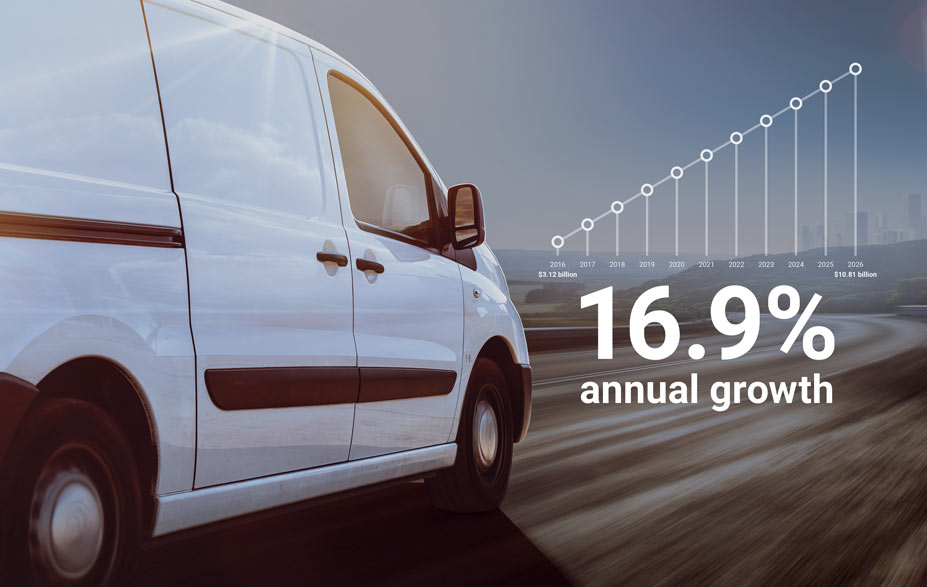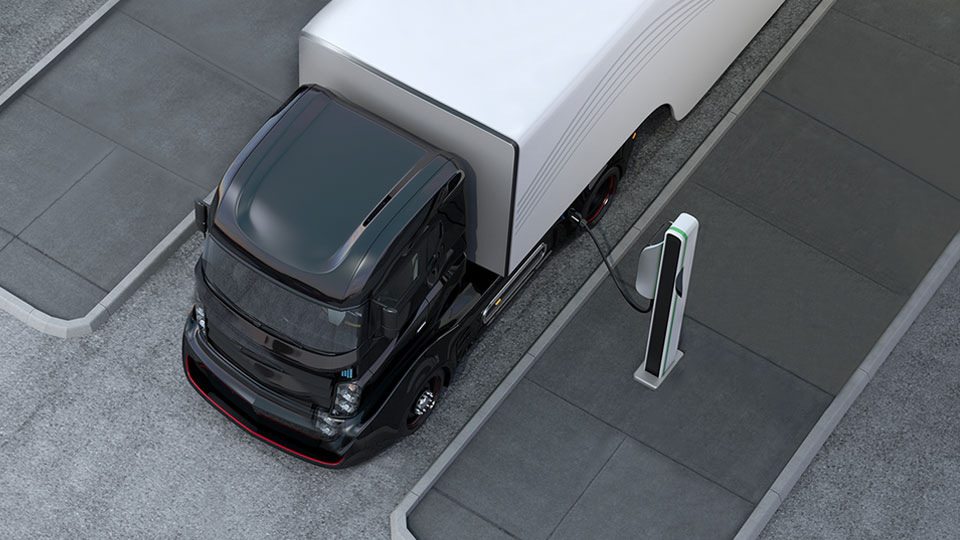
Building a more agile fleet

Table of Contents
The global field service management market — including appointment-based companies that provide either commercial or residential services over a fixed geographic area — is expected to grow 16.9% annually from $3.12 billion in 2018 to $10.81 billion in 2026, according to a recent Allied Market Research report, with North America expected to dominate the market during this period.

This increase means more jobs, more customers and more competition for businesses like general contractors, plumbers, landscapers, HVAC repair, pest control companies and roofers.
Fleets that utilize telematics to its full potential — and take advantage of customizable offerings — will not only position themselves as leaders, but also help their customers be successful too.
Market changes present challenges

While it might be natural to assume that technology is driving changes in the field service industry, it is actually customers who are reshaping field services. Customers are demanding more transparency and real-time information about service events. Field service managers who adapt to these changes will be much more effective which will benefit both their own company and their customers.
By using all the telematics tools available, field service managers can stay ahead of the competition and avoid the challenges below.
Evolving customer expectations
With customers demanding more transparency, digital mobile tools — including apps and customer portals — will provide real-time updates and make communication easier.
Field service fleets that are prepared for changing customer expectations will be one step ahead of the competition. Customers are expecting more uptime, and constant communication from their service providers. It will no longer be enough for a field service operation to give a customer a window of time for when the technician will arrive. Rather, customers are going to want to know within minutes the exact arrival time of the vehicle and technician that will be coming to fix their problem.
In addition, as a result of a pandemic, more businesses are looking for contactless interactions including being able to approve work orders and complete other paperwork without having to have physical contact with the technician.
Economic fluctuations
Economic change, with periods of growth and of recession, is an enduring reality. The Great Recession from 2007 to 2009 was the most severe economic recession since the Great Depression. That was followed by the longest expansion period in modern history.
Changes in demand for products, household disposable income, gas prices and more are always an issue. They are especially relevant today due to the economic effects of COVID-19, which brought stay-in-place orders and the temporary closure of non-essential businesses. Depending on the type of customer they serviced, field service businesses saw their business decline or in some cases temporarily disappear.
Now, the economy is slowly opening back up and field service organizations are beginning to see an uptick in business. However, the uncertainty about when economic conditions will return to more normal levels can make it difficult for field service organizations to make decisions about staffing and asset acquisition, among other things.
Digital transformation
We are living in a time of rapidly evolving technological developments from AI, automation and machine learning, to cloud-based capabilities, predictive and analytics tools. This digital transformation is changing the way businesses operate and how they deliver value to customers. It will change the way field service fleets conduct business and interact with customers. With many options available to them, field service organizations must be mindful of their unique business model and avoid a one-size-fits-all telematics solution.
Sustainability
A global push for companies to be more green will result in hybrid fleets which include electric vehicles.
Field services are ripe for conversion to alternate powered vehicles. Many of them operate in hub-and-spoke duty cycles in which the vehicles return to base at the end of the day, which makes it easier to keep the vehicles charged.
Emissions from traditional gasoline and diesel-powered vehicles will be reduced as a result of more efficient routes that reduce both miles driven and empty miles which results in better fuel economy. It is very important for field service fleets to monitor fuel use, time in idle and to find ways to optimize routing and dispatching.
Increased competition
Shrinking profit margins will require field service fleets to seek new efficiencies and optimize fleet operations. Things like better use of technician time, strategically dispatching vehicles, technicians and route optimization will be critical factors for success.
Becoming an agile fleet
In order to tackle challenges head-on, field service fleets need to be extremely agile so they can quickly adapt to change.

An agile company is one that:
- has the ability to quickly adapt to market changes
- pivots when presented with an unexpected obstacle
- is built on collaboration
Rather than having information siloed in various departments, all information is shared and there is cross communication among various areas of the organization.
An agile fleet will be in the best position to adapt and survive market challenges, placing them ahead of the competitive curve by meeting customer expectations, riding out economic fluctuations, adapting to and integrating emerging technology.
The following strategies can help fleets remain flexible for when challenges inevitably arise:
The right mix of integrated, IoT technology
The right combination of technology will differ for every fleet depending on a business’s operational structure and key drivers, whether that is to reduce costs, increase customer satisfaction or improve driver safety. Using the right mix of technology can help streamline fleet operations, resulting in improved efficiency.
Managers of field service organizations must constantly be balancing customer satisfaction with reducing costs and optimizing revenue. Critical to meeting this need is using a telematics solution that is not a one-size-fits-all solution. Rather, a telematics tool that is customizable and scalable.
What to look for in a telematics system :
- Open platform that allows for custom integrations with SDK
- Allows OEM integrations
- Provides access to an ecosystem of hardware and software integrations
- Lets you customize reports, rule sets and alerts
- Provides device expandability through IOX/external ports
Added value:
- Ability to create customer zones/geofences, dispatch the nearest driver for work orders, manage driver safety and fuel through dashboards that are all within a sales management platform
- Overview of all day-to-day fleet operations, including maintenance management, fuel tracking, and parts and inventory data
- Combines telematics information with planned route information to provide access to GPS data, real-time actual versus plan data and vehicle tracking
- Allows users to create, share, manage and drive optimized route plans quickly.
- Estimates a fleet’s existing and potential cost savings in the areas of safety, fuel, maintenance and productivity based on rich telematics data
- Offers operations managers the ability to seamlessly track and engage with mobile employees, efficiently dispatching jobs to those is the field
The mobile workforce is the backbone of any field service organization, so it is imperative that this group of people have the tools they need to perform tasks accurately and efficiently. Mobile apps for workflow, communication and form generation are essential.
Consider driver apps that allow operations managers to update drivers in real-time, including:
- Technician schedules, the ability to dispatch appointments to drivers in real-time, easy drag and drop interfaces, turn-by-turn routing and work order information such as job description, client history, job status data, eSignatures and photo capture
It is all about customization. Businesses need to be able to customize a solution to fit both their company objectives and their operation needs, in order to create an efficient and optimized mobile workforce.
Smarter use of data analytics
Data is increasingly important to every business. How a field service operation interprets the data it receives from its telematics system can help generate revenue, result in cost savings or make them operate more efficiently.
Customer-centric fleets can use analytics and benchmarking to solve the challenges they face and better serve their customers.
In addition, fleet service companies can use data to help lower both fixed and variable operating costs. The right telematics system can help lower fuel expenses, insurance costs and maintenance costs. Overall, it can help lower total cost of ownership and can be a valuable tool for rightsizing the fleet.
Fleet benchmarking is another data solution that could help fleet managers improve their performance. Gathering data from fleets around the world, benchmarking can offer fleet managers comparable data to better judge how well their fleets are performing in any given area they choose to track.
Benchmarking data can be used to look at a variety of factors including maintenance, routing, trip data, vehicle performance data and more.
Increasing efficiency through automation

Automating processes that were manual means field service fleets will have real-time access to what is happening with their technicians and the vehicles. Monitoring asset health in real-time improves operating efficiency by ensuring that all assets are in top operating condition at all times and utilization is maximized.
The average cost of an on-road breakdown can be expensive, some of the costs include towing, repair parts and technician time but the cost of a breakdown extends far beyond that and includes dissatisfied customers and damage to a company’s reputation — things that are harder to put a dollar amount on. While it is not possible to eliminate all roadside breakdowns, proper preventive maintenance can lead to significantly lower instances. For field service organizations, this means getting to a customers’ location ontime.
Having a preventive maintenance plan in place is a good first step, but getting maintenance compliance from drivers to 100% is more likely to occur when automation is brought in to manage the process. Automation tools can help by keeping track of scheduled maintenance service, sending notifications reminding the fleet manager that a maintenance service is due and sending reminders until that maintenance service is completed. Getting preventive maintenance insights allows field service reps to schedule repairs, improving uptime, reliability, reputation, customer satisfaction and their company’s bottom line.
Other examples include automating the scheduling and dispatching system, allowing vehicles to be deployed in the best manner so field service personnel get to customers faster, and ensure that the right type of field service technician is sent to each customer location. Fleets can use the automated data to monitor and manage costs in order to reduce operating expenses.
The potential for automotion is endless, especially in the realm of telematics. Which is why it is vital that your telematics solution has both an open platform and access to a large Marketplace of integrated third-party hardware and software solutions.
Customer-facing technology
In today’s culture, customers want complete transparency and information in real-time. They want to know what is happening with their service every step of the way.
Automation can alert the customer about the expected arrival time of the technician and can track a technician’s movement which allows the customer to see if there is a delay by traffic or other obstacles. This automation can help reduce the time spent fielding customer phone calls by alerting customers to the time the technician is expected to arrive and even notifying them about delivery delays so they can be better prepared.
Equipping technicians with all of the necessary information surrounding a job results in better customer communications and streamlined scheduling processes. Technicians who have this type of information can anticipate customer needs.
Developing a better trained and more flexible workforce
Captured data about driver behavior, such as time in cruise, time in idle, hard braking or acceleration provide an opportunity to coach drivers on improving their skills, which in turn can increase fleet safety and efficiency. Engage, motivate and coach drivers by turning everyday driving into a friendly competition.
To adapt to fluctuations in demand, field service managers are increasingly looking to add to their talent pool by integrating gig workers or third party contractors into their operation. Driver identification and cloud-based workforce software makes driver data easy to manipulate. There are ways to securely transfer driver identification information to the cloud.
Enhanced communication with dispatch and tools that monitor driver behavior will be essential to ensuring these temporary drivers are meeting company standards. Monitoring driver behavior exceptions such as speed, hard braking, rapid acceleration and lack of seat belt use, helps managers determine the appropriate coaching and corrective actions to take.
A mobile workforce needs the flexibility to use paperless reports, which helps reduce human error and human contact while also getting field service operations managers data in a timely manner.
Preparing a green strategy
The recent COVID-19 stay-at-home orders instituted by many local and state governments demonstrated on a large scale the effect a reduction in combustion engine vehicles on the road can have on the environment. This has inspired a renewed push for sustainability and increased green operations. In addition, many states and municipalities are calling for reduced emissions with some even setting near-zero or zero emissions goals for the near future.
Tracking insights such as fuel economy, CO2 emissions and idling time can help fleets determine if they need to make changes in order to enhance operating efficiency. Identifying idling trends not only fleet-wide but by vehicle or driver can help reduce time in idling and present coaching opportunities to educate drivers.
Field service fleets wanting to demonstrate their commitment to a sustainable business model, or adhere to stricter government mandates, will also need to begin looking into the viability of switching their fleet to hybrid or electric vehicles (EVs). Ensuring that your telematics provider has a one platform solution to monitor and manage EVs and hybrids, alongside your combustion engine vehicles is essential.
Conclusion
In order to be agile, fleets need to partner with a telematics provider that is dedicated to providing innovative and customizable telematics solutions.
Geotab recognizes that no two fleets are alike. We have engineered fleet management solutions that provide unlimited flexibility to adapt to changing industry needs and challenges along with evolving business objectives.
The Geotab solution allows field service fleets to:
- Enhance the customer experience by notifying them of arrival times, allowing for shorter arrival windows, matching technical skills to each job and providing contactless options
- Optimize routing and dispatching by using dynamic routing and being able to quickly react to weather conditions, traffic congestion, emergency calls and much more
- Schedule more jobs per technician by monitoring planned time on a job versus actual time on a job and adjusting schedules accordingly
- Driver app with map integrations, voice-guided turn-by-turn directions, push notifications and drag-and-drop appointment schedules
- One platform solution for EV, hybrids, and combustion engine vehicles
- Robust, data driven reports for actionable insights reducing both fixed and operational costs, such as fuel and insurance costs
Each field service fleet has to monitor what matters to them. Finding the right mix of flexible technology, tapping in to data and analytics, investing in training, and going green are several strategies to help build fleet agility — for now and the future.
Post Tags
About Geotab
Geotab is a global leader in connected vehicle and asset solutions, empowering fleet efficiency and management. We leverage advanced data analytics and AI to transform fleet performance, safety, and sustainability, reducing cost and driving efficiency. Backed by top data scientists and engineers, we serve over 55,000 global customers, processing 80 billion data points daily from more than 4.7 million vehicle subscriptions. Geotab is trusted by Fortune 500 organisations, mid-sized fleets, and the largest public sector fleets in the world, including the US Federal Government. Committed to data security and privacy, we hold FIPS 140-3 and FedRAMP authorisations. Our open platform, ecosystem of outstanding partners, and Marketplace deliver hundreds of fleet-ready third-party solutions. This year, we're celebrating 25 years of innovation. Learn more at www.geotab.com/apac, and follow us on LinkedIn or visit our blog.
© 2025 Geotab Inc.All Rights Reserved.
This white paper is intended to provide information and encourage discussion on topics of interest to the telematics community. Geotab is not providing technical, professional or legal advice through this white paper. While every effort has been made to ensure that the information in this white paper is timely and accurate, errors and omissions may occur, and the information presented here may become out-of-date with the passage of time.
Recent News

Data-driven smart city insights: intelligent datasets and urban analytics for digital cities
September 26, 2022

Driver safety scorecards: the first step to a safer fleet
September 26, 2022

Medium and heavy-duty electrification trends
September 26, 2022

Government fleet electrification: Making the transition to EVs
September 26, 2022
